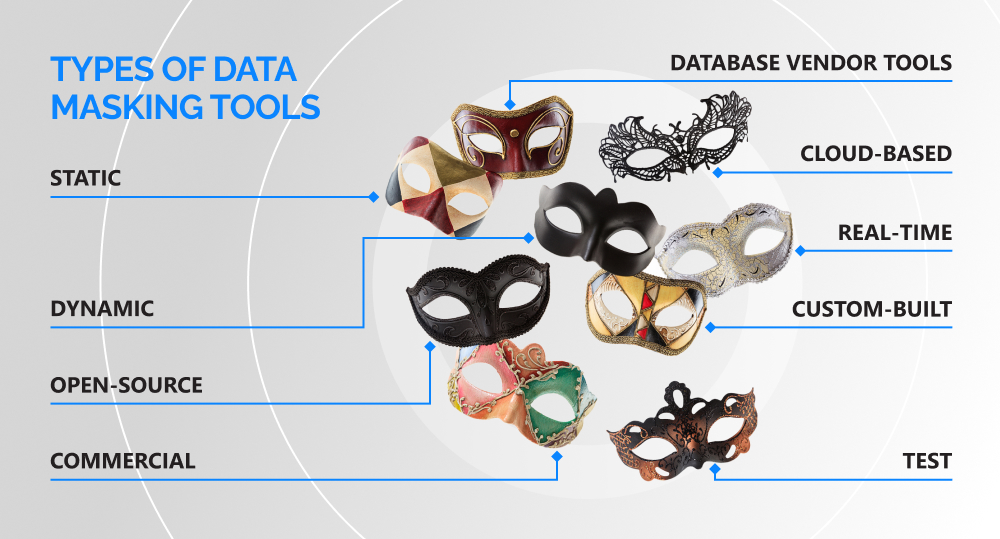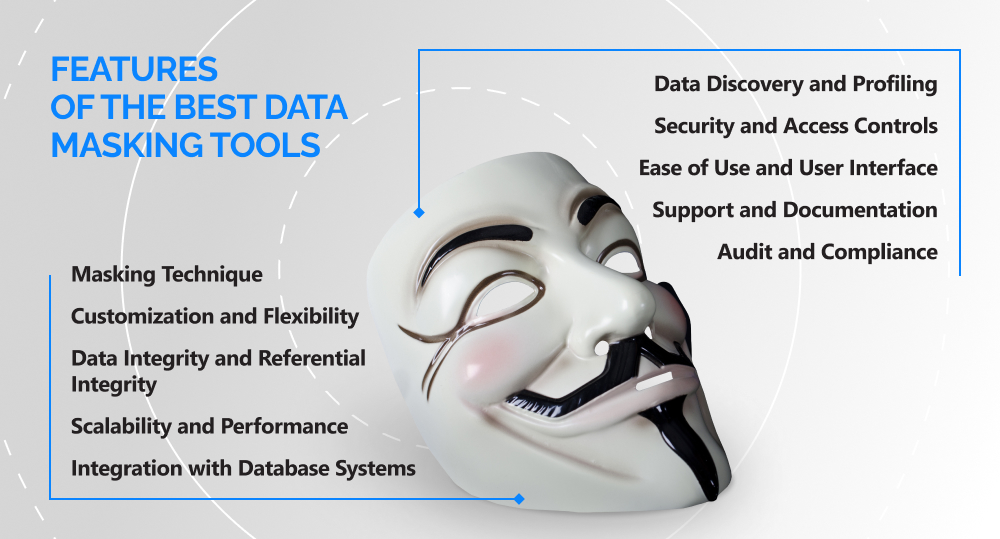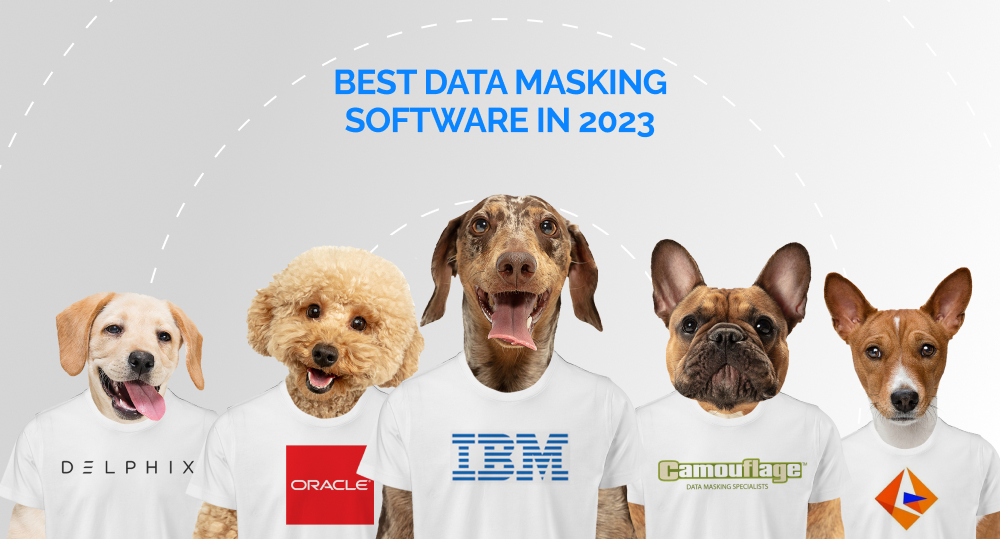Data masking tools have emerged as crucial assets in an era of increasing data breaches and privacy regulations. Are you concerned about the security of your sensitive information? No worries. Data masking software can make it virtually invisible to prying eyes. These solutions empower businesses to safeguard their data and comply with privacy requirements, such as GDPR, CPRA, etc.
In this article, we explore the top data masking tools available in the market, discuss their features and benefits, and provide you with a data masking software comparison table.
written by:
Maxim Butov
Software Architect
Data masking tools have emerged as crucial assets in an era of increasing data breaches and privacy regulations. Are you concerned about the security of your sensitive information? No worries. Data masking software can make it virtually invisible to prying eyes. These solutions empower businesses to safeguard their data and comply with privacy requirements, such as GDPR, CPRA, etc. In this article, we explore the top data masking tools available in the market, discuss their features and benefits, and provide you with a data masking software comparison table.
Contents
Data Masking at a Glance
Data masking is a technique used to protect sensitive information by replacing it with fictional or altered data while preserving its format and usability for non-production purposes. It will help you protect your confidential data during testing, development, and analysis, minimizing the risk of unauthorized access. Simply put, it's like giving a disguise to sensitive information, allowing it to be used in non-secure environments without compromising its privacy and integrity. Do you need more examples? It's like putting a mask on your data, ensuring that only authorized individuals can access the real information behind the mask.
What Is a Data Masking Tool?
Data masking tools are software solutions designed to automate and simplify the process of data obfuscation. They will provide you with a set of functionalities and techniques to protect sensitive information during non-production activities, such as testing, development, or analytics. They offer various masking methods, such as substitution, encryption, tokenization, and shuffling, to alter or obfuscate sensitive information while maintaining the integrity and usability of the data. These solutions usually have data discovery, classification, and masking rule management features, allowing you to identify and protect sensitive data across different databases and systems.
Types of Data Masking Tools: Open-Source and Others
You can find various types of data masking tools in the market that cater to different needs and environments. Here they are:
Static Data Masking Tools
A static data masking tool usually creates a static, masked copy of the original data that can be used for development, testing, and analytics purposes. Static data masking replaces sensitive information with realistic but fictitious data, ensuring that the masked data retains the same structure and characteristics as the original.
Dynamic Data Masking Tools
On the other hand, dynamic data masking tools provide real-time data masking capabilities that dynamically mask sensitive information at the point of access. These tools apply masking rules on the fly, ensuring that only authorized users see the original data. In contrast, unauthorized users or those with restricted privileges view masked or obfuscated versions of the data.
Commercial Data Masking Tools
These are comprehensive, feature-rich solutions offered by established software vendors. They provide a wide range of data masking techniques, customization options, scalability, and integration capabilities. Commercial software often comes with user-friendly interfaces, support, and documentation, making them suitable for organizations of all sizes.
Open-Source Data Masking Tools
Open-source or free data masking software provides a cost-effective alternative for businesses looking to mask data without significant financial investment. It's developed and maintained by communities of contributors and offers flexibility for customization. However, free data masking tools may require more technical expertise for implementation and ongoing maintenance.
Cloud-Based Data Masking Services
With the rise of cloud computing, cloud-based data masking services have emerged. These services provide data masking as a service (DMaaS), allowing organizations to leverage the scalability, flexibility, and convenience of the cloud. They often offer built-in security measures and integration with cloud platforms, making them suitable for cloud-based environments.
Database Vendor Tools
Many database vendors provide built-in data masking features as part of their database management systems. These solutions offer native integration, optimized performance, and seamless compatibility with the specific database platform. Companies already using a particular database vendor may find these tools convenient and efficient.
Custom-Built Data Masking Solutions
Would you prefer to develop your own data masking solutions tailored to your needs? You can create custom scripts or applications using programming languages like Python, Java, or SQL to implement the desired masking techniques. Please remember that custom-built solutions provide maximum flexibility but require dedicated development resources.
Real-Time Data Masking Tools
A real-time data masking tool provides on-the-fly data masking capabilities to protect sensitive information in real-time as it is accessed or transmitted. It dynamically masks sensitive data at the moment of use, ensuring that unauthorized individuals or processes cannot view the original sensitive information.
Test Data Masking Tools
These solutions are designed to protect sensitive data during software testing and development activities. They create a secure testing environment that mirrors the production environment while safeguarding confidential information.
So, there are a lot of data masking tools: for free download or commercial. Choosing the right instrument depends on your requirements, such as the desired masking techniques, scalability, integration capabilities, and available resources. Let's look at the features that a good data masking solution should have.
What Features Should the Best Data Masking Tools Have?
Data masking tools should have a range of features to effectively address your data privacy and security needs. Here are key features to consider when evaluating a data masking tools list:
Masking Technique
A data masking tool should offer a variety of masking techniques to accommodate different data types and privacy requirements. This may include substitution, shuffling, encryption, tokenization, or data scrambling. The solution should support both reversible and irreversible masking methods.
Customization and Flexibility
Customizing masking rules and techniques is crucial to align the tool with specific data privacy laws and requirements. It should allow you to define and apply masking rules based on their unique data structures and sensitive information.
Data Integrity and Referential Integrity
Data masking tools should maintain the integrity and consistency of data during the masking process. They should preserve referential integrity between related data elements or tables, allowing for accurate analysis and testing without compromising data relationships.
Scalability and Performance
The solution should be capable of handling large volumes of data efficiently, ensuring minimal impact on system performance. It should be scalable to accommodate the growth of data and your company's evolving needs.
Integration with Database Systems
Compatibility and integration with various database systems, platforms, and data environments are crucial. Your ideal data masking tool should seamlessly integrate with the existing infrastructure, enabling smooth data masking operations without disrupting workflows.
Data Discovery and Profiling
Advanced data discovery capabilities are beneficial for identifying sensitive data elements within complex databases. Data masking tools should provide profiling features to analyze the data and assist in determining the appropriate masking techniques for different data types.
Security and Access Controls
Robust security features are essential to protect sensitive data during the masking process. Choose the solution that is able to provide encryption and secure key management capabilities. Remember about access controls to ensure authorized access to the masked data and prevent unauthorized users from unmasking the data. Cyber attackers compromised almost 42 million records in March 2023. Use these solutions to save your structured and unstructured data!
Audit and Compliance
Choose the software that offers comprehensive auditing capabilities, generating detailed logs and reports of masking activities for compliance purposes. It should support compliance with data protection regulations such as GDPR, HIPAA, or PCI DSS.
Ease of Use and User Interface
An intuitive user interface simplifies the configuration and management of masking operations. A good solution should be user-friendly, allowing users with varying levels of technical expertise to effectively utilize its functionalities.
Support and Documentation
The tool's vendor should provide reliable support, including documentation, training resources, and responsive customer assistance. Timely updates and patches should be available to address any security vulnerabilities or feature enhancements.
Consider these features when selecting a data masking tool to ensure it meets your company's requirements and provides effective data privacy while maintaining data usability and integrity.
Best Data Masking Software in 2024
So, it's time to explore popular data masking tools and compare them to choose the best one.
Delphix Masking
Delphix Masking offers comprehensive data masking capabilities with features, such as synthetic data generation, data discovery, masking rule customization, and support for various database platforms. It helps companies protect private data during development and testing. The solution provides a wide range of data masking techniques, including substitution, encryption, tokenization, and shuffling. It automatically detects and secures more than 30 different types of sensitive information, such as customer names, email addresses, credit card numbers, and so on.
With over 50 unique profiling expressions, Delphix boasts an extensive library of pre-built profile sets, making it easy to execute masking algorithms without requiring advanced programming skills. The software ensures the preservation of referential integrity within and across your data sources, providing accurate masked values. It goes the extra mile in ensuring data privacy and security by offering solutions for data tokenization and irreversible masking. This allows you to comply with standards and regulations, such as GDPR, HIPAA, or CCPA.
Informatica Persistent Data Masking
Informatica's solution provides many data masking methods, such as format-preserving masking, encryption, and tokenization. It offers automation capabilities, policy-based masking, and integration with Informatica's broader data management suite. The tool will allow you to create de-identified data sets that closely resemble real data at high speed. It enables masking when creating test data sets, both "on-the-fly" and "in-place," directly in the existing data table. You can utilize a business glossary to describe data masking rules and policies and reuse them for consistent masking across different datasets.
Informatica Persistent Data Masking can create environment copies and manage them for various applications and databases, such as Oracle, DB2, SQL Server, Sybase, Teradata, and platforms including Windows, UNIX/Linux, and z/OS. It standardizes copy management policies across all company systems and adapts procedures according to your business requirements.
Oracle Data Masking and Subsetting
The tool supports various masking techniques, including format-preserving masking, encryption, randomization, and shuffling. It provides flexibility in choosing the most appropriate method for different data types and privacy requirements. Oracle Data Masking and Subsetting allows you to classify data based on privacy levels and apply masking selectively, as well as define and customize masking rules based on your specific requirements.
In addition, Oracle's solution offers data subsetting capabilities. For example, it allows businesses to create smaller, representative subsets of their databases for non-production environments, reducing storage and infrastructure requirements. The tool seamlessly integrates with Oracle's broader ecosystem, including Oracle Database, Oracle Enterprise Manager, and Oracle Data Integrator. This ensures compatibility, ease of use, and streamlined data management across the Oracle environment.
IBM InfoSphere Optim Data Privacy
IBM offers a robust data masking tool that provides a range of masking techniques, including data encryption, format-preserving masking, tokenization, and data shuffling. One of the key features of IBM InfoSphere Optim Data Privacy is its ability to create realistic and representative test data. In other words, it enables you to generate masked test data sets that closely resemble the original data, ensuring accurate testing and development processes while maintaining data privacy.
You can also identify sensitive data across various data sources and gain insights into data relationships. This helps understand the scope of data privacy requirements and ensure comprehensive protection. The solution easily integrates with existing data management systems, databases, and applications, making it easier to implement and manage data masking processes. It supports a wide range of platforms and databases, including Oracle, DB2, SQL Server, and more. Using this tool, you can enhance data security, mitigate the risk of data leaks, and comply with GDPR, HIPAA, and PCI-DSS regulations.
Camouflage Software
Camouflage Data Masking Software offers comprehensive features and capabilities to safeguard data across various data sources and environments. It provides a variety of masking methods, including encryption, tokenization, substitution, shuffling, and format-preserving techniques. It transforms sensitive data into realistic, yet unidentifiable, representations, allowing you to use it for testing, development, analytics, and other non-production purposes without compromising data privacy.
Camouflage Software supports many data sources, including relational databases, files, mainframes, and cloud-based platforms. It integrates seamlessly with popular database systems like Oracle, Microsoft SQL Server, IBM DB2, and others. This flexibility enables you to protect critical sensitive data across the entire data landscape. Moreover, the tool provides a centralized dashboard for managing and monitoring the data masking process, allowing you to track and audit data access and usage.
In addition to data masking, Camouflage Software offers features like data subsetting, data scrambling, and synthetic data generation. This means that you can create representative subsets of data for non-production environments. It provides detailed reporting and audit trails so that you will be sure that your sensitive data is adequately protected and controlled.
We've made a brief data masking tools comparison table to show the differences between top 5 solutions.
Data Masking Tool
Key Features
Pros
Cons
Delphix Masking
Automatic sensitive data detection
High performance and scalability
Higher cost compared to some alternatives
Informatica Persistent Data Masking
Real-time and batch data masking
Comprehensive masking techniques
Requires expertise to fully utilize features
Oracle Data Masking and Subsetting
Format-preserving and value-preserving masking
Seamless integration with Oracle databases
Limited support for non-Oracle databases
IBM InfoSphere Optim Data Privacy
Diverse masking techniques and encryption
Advanced data discovery and classification
Complex implementation and management
Camouflage Software
Encryption, tokenization, and data subsetting
Wide range of data source support
Limited information on pricing and support
Bottom Line
The data masking market value stood at $725.13 mln in 2022 and is expected to reach $2,174.61 mln in 2030. These figures confirm that data mask tools play a crucial role in protecting sensitive data, ensuring regulatory compliance, and minimizing the risk of data compromises. These solutions allow you to secure information across various data sources, including databases, files, and mainframes. They offer ease of integration, scalability, and support for regulatory compliance requirements, such as GDPR, HIPAA, and PCI-DSS.
In the today's digital world, where security risks spring up like mushrooms, posing a threat to the business infrastructure and sensitive information, it is extremely vital to select data masking tools carefully and timely. When making this critical decision and elaborating a data masking strategy, take into account your project requirements, budget, and software integration capabilities and compliance standards. Such an approach will save your resources and let you enjoy sound sleep for years to come.
FAQ
#1 What Is Data Masking Software?
Data masking software is a type of software tool designed to protect sensitive or personally identifiable information (PII) by replacing it with fictitious, yet realistic, data. It is commonly used in development, testing, and data-sharing environments to ensure data privacy and security. Using data masking software, organizations can minimize the risk of data breaches, unauthorized access, and insider threats. It allows developers, testers, and analysts to work with realistic datasets that preserve the characteristics of the original data while ensuring that sensitive information remains protected. There are various types of data masking software: open-source and commercial.
#2 How to Do Data Masking?
Data masking involves transforming sensitive data so that it becomes unidentifiable and meaningless while preserving the format and structure of the original data. Here are the general steps involved in performing data masking:
1. Identify sensitive data
Determine the specific data elements that need to be masked. This may include personally identifiable information (PII) like names, addresses, social security numbers, financial data, or any other data that requires protection.
2. Define masking rules
Establish rules and techniques for masking each type of sensitive data. Different types of data may require other masking methods. For example, names can be replaced with random or fictional names, while credit card numbers can be masked by preserving the last few digits and replacing the rest with random numbers.
3. Choose a data masking technique
Select the appropriate data masking technique based on the requirements and regulations governing the data. Common techniques include encryption, tokenization, scrambling, shuffling, or data substitution.
4. Develop a data masking plan
Create a plan outlining the steps and processes involved in masking the data. This plan should include details about the data sources, masking techniques, and additional considerations or requirements.
5. Implement data masking
Apply the masking rules and techniques to the sensitive information. Use the required data masking software or custom scripts.
6. Test and validate
Verify that the masked data retains its usability and functionality while ensuring that the sensitive information is effectively obscured. Test the masked data in various scenarios to ensure it meets the intended requirements.
7. Monitor and maintain
Regularly review and update the data masking process to accommodate changes in the data or requirements. Implement appropriate security measures to protect masked data during storage, transmission, and usage.
#3 What Is Data Masking Technique?
Data masking techniques are methods used to transform sensitive data into a masked or obfuscated form while preserving the integrity and usability of the data. The most used data masking methods include substitution, shuffling, encryption, tokenization, data scrambling, etc. Businesses lost $4.35 mln in 2022 due to data breaches. So, it's essential to apply various security measures to save your secrets.
#4 Can You Unmask Masked Data?
Yes, it is theoretically possible to unmask masked data, depending on the specific masking techniques used and the resources and knowledge available to the attacker. However, the effectiveness of data masking is to make it extremely difficult for unauthorized parties to reverse the masking process and retrieve the original sensitive information. Robust masking techniques, secure key management, and access controls should be implemented to minimize the risk of unmasking masked data.
#5 Is Data Masking the Same as Obfuscation?
No, data masking and obfuscation are not the same. Data masking involves transforming sensitive data into a fictitious but realistic form while preserving the data's structure and usability for legitimate purposes. The objective is to protect sensitive information while maintaining data integrity. On the other hand, obfuscation refers to intentionally making data confusing, complex, or less understandable to prevent unauthorized access or reverse-engineering. Obfuscation does not necessarily preserve the data's structure or usability and aims to make the data less readable or meaningful.
#6 How Do You Mask Data for Testing?
When it comes to masking data for testing, we want to keep things both secure and practical. The goal is to create usable datasets that mimic real data while safeguarding sensitive information. Here's the process we follow:
First, we identify sensitive data that needs protection (e.g., names, addresses, or financial details). Then, we define masking rules, determining how we'll transform the data. It could involve techniques like substitution, shuffling, or encryption.
Next, we choose a data masking tool or develop our scripts to implement the masking process. This ensures consistency and efficiency. We apply the masking rules to the sensitive data, creating masked values that look and behave realistically.
Once the data is masked, we validate it to ensure it retains its integrity and usability. We perform thorough tests to ensure the masked data behaves as expected during testing scenarios.
Lastly, we manage the masked data securely, controlling access and ensuring it's used only for approved testing purposes. We follow data retention policies and data sharing agreements to keep everything in check.
By masking the data for testing, we strike a balance between data privacy and usability, enabling us to carry out effective testing while protecting sensitive information.
#7 How Do You Mask Data in SQL?
There are data masking tools for SQL server as well. To mask data in SQL, you can use various techniques and functions depending on the specific database system you are working with. Here are a few common methods:
UPDATE statement with masking functions
You can use the UPDATE statement to modify the sensitive information in a table, replacing it with masked values generated by specific functions. For example, you can use functions like SUBSTRING, CONCAT, or RANDOM to create masked values. Here's an example for masking a phone number column with 'X' characters:
UPDATE your_table
SET phone_number = CONCAT('XXX-XXX-', SUBSTRING(phone_number, -4))
Views
Views allow you to create virtual tables that present a masked version of the original data. By selecting specific columns and applying masking functions in the view definition, you can ensure that only masked values are visible to the users. Keep in mind that views do not physically modify the underlying data but provide a masked representation.
CREATE VIEW masked_view AS
SELECT column1, column2, SUBSTRING(column3, 1, 3) || 'XXX' AS masked_column
FROM your_table
Masking functions in SELECT queries
When retrieving data from the database, you can use masking functions within the SELECT statement to dynamically mask sensitive data. This approach lets you keep the original data intact while presenting masked values to the users. For example:
SELECT column1, column2, CONCAT('XXX-XXX-', SUBSTRING(phone_number, -4)) AS masked_phone
FROM your_table
Stored procedures or user-defined functions
You can create stored procedures or user-defined functions that encapsulate the logic for masking private information. These procedures/functions can be invoked whenever data needs to be retrieved or modified, ensuring consistent application of masking rules.
It's important to note that the specific functions and syntax for masking data may vary depending on your database system. Refer to the documentation of your database system for the available masking functions and syntax relevant to your environment. Additionally, ensure that you have the necessary privileges and backups in place before performing any data masking operations to prevent accidental data loss or irreversible changes.
Looking for a secure data masking tool to safeguard your confidential information? Call us, and we will help you choose the right instrument.

Contacts
Feel free to get in touch with us! Use this contact form for an ASAP response.
Call us at +44 151 528 8015
E-mail us at request@qulix.com










